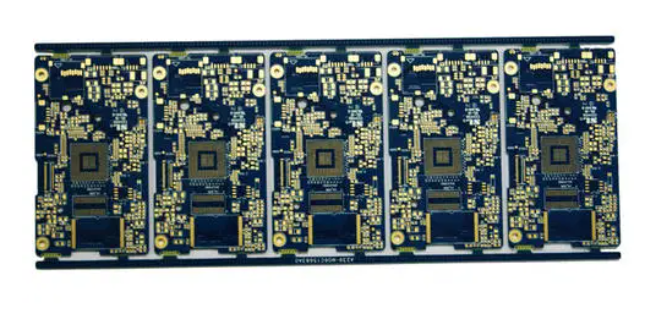Reliability of the plating layer on the circuit board?
Reliability of electroplating layer on PCBA board
(1) Defects in the coating produced during the manufacturing process, such as poor adhesion, voids or unevenness in the coating.
(2) Poor connection caused by residue of glue. Finding problems depends on a full understanding of the process and quick feedback when they occur.
Most of the problems found in the reliability of plated through-hole plating are local defects. Due to the high replacement rate of electronic equipment in recent years, the use time is not very long, so there is a phenomenon of relaxation in the setting of reliability. It is often heard that the so-called service life of 10,000 hours to 20,000 hours is mostly simulated. Using about eight hours a day, hypothetical figures over three or six years can be used. Due to the recent history of high-density build-up circuit boards, long-term reliability data is still insufficient and cannot fully reflect the reliability of actual products. Therefore, only a moderate discussion can be made based on the limited information currently known.
(A) Reliability of plated through holes
The reliability of plated through holes has been discussed in many different products and applications. The circuit board has undergone thermal stress testing, and an example of stress fracture at the corner of the hole. It is confirmed from previous studies that the stress fracture of plated through holes is not only related to the physical properties of the copper plating layer, but also related to the geometric shape and size of the hole. Due to thermal expansion, different materials will produce different amounts of deformation. Unbalanced deformation will cause the through-hole plating layer to pull, so it may break or peel off the inner layer of copper on the hole wall.

The general cause of fracture is mostly caused by cold and hot cycles. The test method is to use the stress generated by thermal shock and thermal cycle, and simulate the actual equipment operating conditions through repeated fatigue stress tests.
At this time when circuit boards are moving towards high-density and multi-layered, high-quality multi-layer circuit boards can be easily made by selecting appropriate resin materials and designing appropriate circuit board structures in the face of more complex assembly procedures. In the past, the thickness of copper plating for through-holes was mostly based on the lowest thickness of lmil. Recently, because the thickness of the board has been kept low with the appearance of the thin wire process, the change in thermal expansion in the vertical direction is relatively small, so the plating degree has also been relaxed. The phenomenon.
(B) Reliability of blind hole plating
Blind holes used in high-density build-up circuit boards generally have a depth design range of about 30-100m. Compared with traditional through holes, the thickness of copper plating can be thinner, and the generally defined thickness is about 10-20m. Due to the limited depth of the blind hole, the general problem does not lie in the corner of the hole. On the contrary, due to the chemical copper treatment or laser drilling factors, the blind hole is placed between the bottom of the hole and the copper pad after the reliability test. The interface is broken. Most of these reasons are due to the lack of cleanliness of the interface. There are more opportunities. Figure 2 shows an example of a blind hole that has undergone a reliability test.
The structure of high-density build-up circuit boards has now accumulated more information, which shows that such circuit boards still have good reliability.
(C) The relationship between the glue residue and the degree of communication dependence
In a multilayer circuit board, the quality of the connection between the plated through-hole plating and the inner layer is very important. The scum produced or left during mechanical drilling or laser drilling operations will have a great impact on the integrity of the connection. Generally, the requirements for slag are almost the same, that is, no slag is allowed between the hole wall and the hole copper. After the current drilling process, scum removal is generally done, and poor conduction caused by scum residue is rare. Of course, for a design with a relatively close hole spacing, excessive removal of slag will cause poor insulation. The manufacturer must not have the idea of removing the glue as cleanly as possible. The amount of glue removal must be appropriately controlled. Of course, the best way is to improve the drilling and reduce the generation of glue residue.
(D)) Reliability of inner circuit and hole copper connection
The plating layer connected with the inner circuit, such as: the connection of the inner copper layer of the multilayer printed circuit board and the through-hole plating, the connection of the blind hole of the build-up circuit board and the bottom circuit, etc. If the reliability is poor, it is difficult to judge, and if it is already in use, the problem will be more complicated.
Related items that affect the quality of reliability are: the pretreatment of inner copper in chemical copper, the physical properties of chemical copper, and the physical properties of electroplated copper. These items must be reviewed individually to control the problem.
For the chemical copper process, the palladium used as the chemical copper catalyst is adsorbed on the wall of the through hole, and a uniform chemical copper plating layer is produced by tight adsorption. However, since palladium has no binding force in the inner copper part, if it still exists between chemical copper and electroplated copper, it will hinder the combination of the two. Therefore, a microetching agent should be used in advance to remove the pore sizer on the inner copper layer so that the palladium cannot be adsorbed.
When the chemical copper is processed well and the production process of electroplated copper is transferred, attention should be paid to the clean state of the copper interface. Good cleanliness is the guarantee of the quality of electroplating.